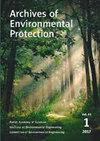Distillery wastewater decolorization by Lactobacillus plantarum MiLAB393
IF 1.3
4区 环境科学与生态学
Q4 ENVIRONMENTAL SCIENCES
引用次数: 6
Abstract
2014), yeast (Tiwari et al. 2014, Mahgoub et al. 2016) and bacteria (Santal et al. 2016, Boopathy and Senthilkumar 2014) for color removing. Because of high pollution loads, many researchers treat vinasse before decolorization. The vinasse is centrifuged, fi ltered or anaerobically treated (Tiwari and Gaur 2014, Boopathy and Senthilkumar 2014, Tondee and Sirianuntapiboon 2008, Ravikumar et al. 2013). Other researchers did not use wastewater from distilleries but synthetic melanoidins, which are easier to decolorize (Agnihotri 2015, Santal et al. 2016). In our study we used sugar beet molasses vinasse without pretreatment. Moreover, this kind of wastewater has not been tested by other researchers because they have focused on cane vinasse (Espana-Gamboa 2015, Shukla 2014). The aim of our study was to optimize the medium composition and the process conditions of sugar beet molasses vinasse decolorization by Lactobacillus plantarum MiLAB393. The optimization of the concentrations of glucose and yeast extract using experimental design (DOE) was made at the stage of shake-fl ask cultures. During the batch experiment, the Abstract: Sugar beet molasses vinasse is a high-strength distillery wastewater. It contains colored substances which signifi cantly aff ect the degree of pollution and toxicity of vinasse. This study aimed to optimize the medium composition and the process condition of sugar beet molasses vinasse decolorization by Lactobacillus plantarum MiLAB393. The research was conducted in two stages: the shake-fl ask stage in the 250 cm 3 Erlenmeyer fl asks and the batch experiments in the 5 dm 3 working volume stirred-tank bioreactor. During the study, the concentrations of glucose and yeast extract were optimized using experimental design of experiments (DOE). The infl uences of the initial value of pH and pH control, temperature, stirrer speed and glucose concentration on decolorization were tested. The highest color reduction of 24.1% was achieved for an experiment in which 24.93 g/dm 3 of glucose was added to the medium and stirrer speed was 200 rpm. This effi ciency of 30% v/v sugar beet molasses vinasse decolorization was obtained at non-controlled pH 6.0 and at 35.8°C. It was found that pH control determines vinasse decolorization. When the pH was controlled, decolorization did not exceed 9%. The glucose and yeast extract concentration and the stirrer speed have a great infl uence on the process. Changes in these parameters may increase biomass growth while decreasing the decolorization.植物乳杆菌MiLAB393对酿酒厂废水的脱色研究
酵母(Tiwari et al. 2014, Mahgoub et al. 2016)和细菌(Santal et al. 2016, Boopathy and Senthilkumar 2014)用于脱色。由于高污染负荷,许多研究人员在脱色前处理酒糟。对酒液进行离心、过滤或厌氧处理(Tiwari and Gaur 2014, Boopathy and Senthilkumar 2014, Tondee and Sirianuntapiboon 2008, Ravikumar et al. 2013)。其他研究人员没有使用酿酒厂的废水,而是使用更容易脱色的合成类黑素(Agnihotri 2015, Santal et al. 2016)。在我们的研究中,我们使用甜菜糖蜜酒液未经预处理。此外,这类废水还没有被其他研究人员测试过,因为他们专注于甘蔗酒液(Espana-Gamboa 2015, Shukla 2014)。本研究旨在优化植物乳杆菌MiLAB393对甜菜糖蜜酒糟脱色的培养基组成和工艺条件。采用实验设计法(DOE)对摇摇培养阶段葡萄糖和酵母浸膏的浓度进行了优化。摘要:甜菜糖蜜酒糟是一种高强度的蒸馏废水。它所含的有色物质对酒糟的污染程度和毒性有显著影响。本研究旨在优化植物乳杆菌MiLAB393对甜菜糖蜜酒糟脱色的培养基组成和工艺条件。研究分两个阶段进行:250cm3的Erlenmeyer生物反应器中的摇床阶段和5dm3工作体积的搅拌槽生物反应器中的批量实验。在研究过程中,采用试验设计法(DOE)对葡萄糖和酵母浸膏的浓度进行优化。考察了pH初始值、pH控制值、温度、搅拌速度和葡萄糖浓度对脱色效果的影响。当培养基中加入24.93 g/dm / 3的葡萄糖,搅拌速度为200 rpm时,颜色降低率最高,为24.1%。在非控制pH 6.0和35.8℃条件下,甜菜糖蜜酒液脱色效率为30% v/v。发现pH值的控制决定了酒液的脱色效果。控制pH时,脱色率不超过9%。葡萄糖和酵母浸膏的浓度和搅拌速度对发酵过程有很大的影响。这些参数的变化可以增加生物量的增长,同时降低脱色。
本文章由计算机程序翻译,如有差异,请以英文原文为准。
求助全文
约1分钟内获得全文
求助全文
来源期刊

Archives of Environmental Protection
ENVIRONMENTAL SCIENCES-
CiteScore
2.70
自引率
26.70%
发文量
0
期刊介绍:
Archives of Environmental Protection is the oldest Polish scientific journal of international scope that publishes articles on engineering and environmental protection. The quarterly has been published by the Institute of Environmental Engineering, Polish Academy of Sciences since 1975. The journal has served as a forum for the exchange of views and ideas among scientists. It has become part of scientific life in Poland and abroad. The quarterly publishes the results of research and scientific inquiries by best specialists hereby becoming an important pillar of science. The journal facilitates better understanding of environmental risks to humans and ecosystems and it also shows the methods for their analysis as well as trends in the search of effective solutions to minimize these risks.
 求助内容:
求助内容: 应助结果提醒方式:
应助结果提醒方式:


